ErasmusLadder
Testing procedure
The ErasmusLadder test requires a mouse to walk a horizontal ladder consisting of 74 pairs of rungs. The rungs are equipped with touch sensitive sensors, allowing the system to detect the position of the mouse on the ladder and determine the placement of the front paws.
Walking the ladder
On each side the rungs alternate between a high and low position, as in each high rung is opposite a low rung, and vice versa. Rungs are strategically placed at a specific distance apart, making the test challenging enough for wild type mice but not too difficult for mice with extreme motor dysfunction to cross.
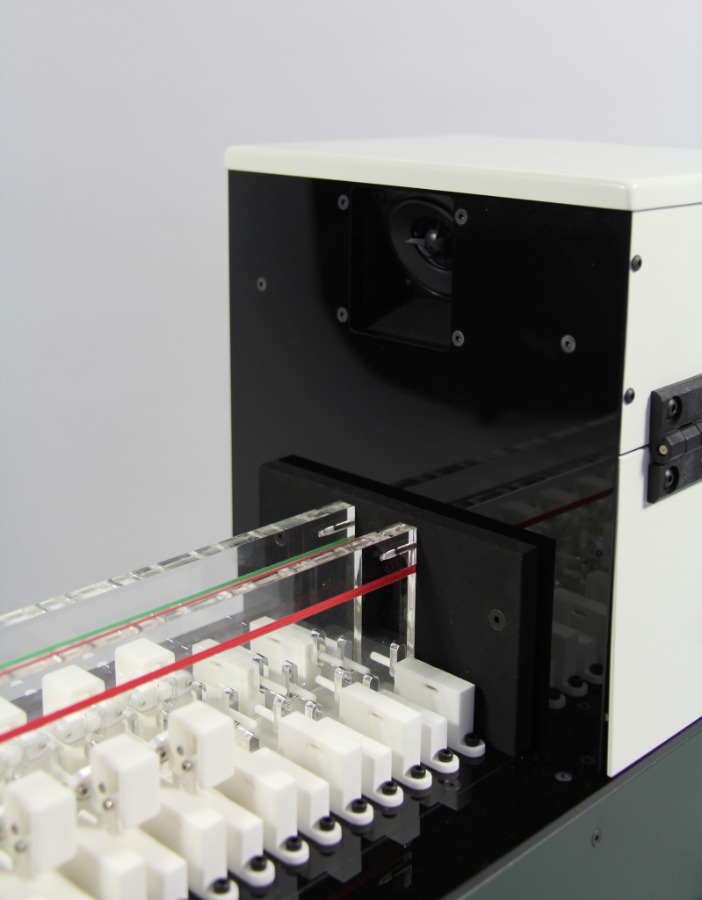
Training and missteps
In principle, it is most convenient for mice to cross the ladder using the higher rungs. A misstep is thus defined as using one of the low rungs. Cupido et al. show that while wild type and mutant mice do make missteps, after several training sessions the mutant mice tested were always able to complete the task.
Motivating the mouse
The horizontal ladder begins and ends with a goal box. A bright light urges the photophobic mouse to leave its current goal box and run to the other, still dark goal box, crossing the ladder to do so. Cupido et al. show that this is not enough motivation – mice will pause and explore the ladder or reverse direction if left to their own devices. To counter this, the ErasmusLadder apparatus also includes pressurized air outlets: a tailwind makes sure the mice are motivated to cross the ladder in a consistent manner and discouraged from sitting still.
Testing procedure with ErasmusLadder
The standard protocol for the ErasmusLadder test was developed at the Erasmus Medical Center (Rotterdam, The Netherlands) and includes eight sessions, one session per day, for each animal. Each session includes 42 runs; half of these are to assess motor performance and motor learning over time, while the other half more specifically assess associative motor learning in a challenge-test. The protocol is explained below, but you can customize your tests by changing the number of sessions or trials or the composition of the trials, for example by adjusting the timing of the light and air cue.
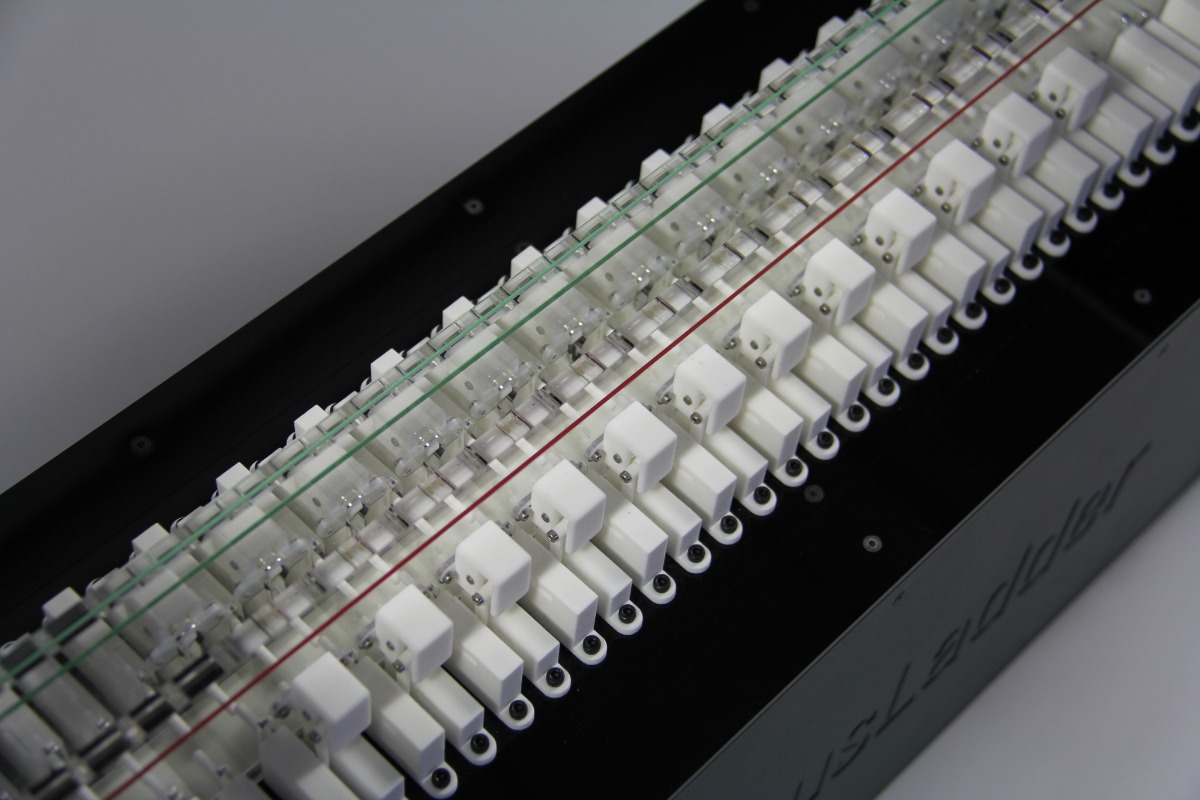
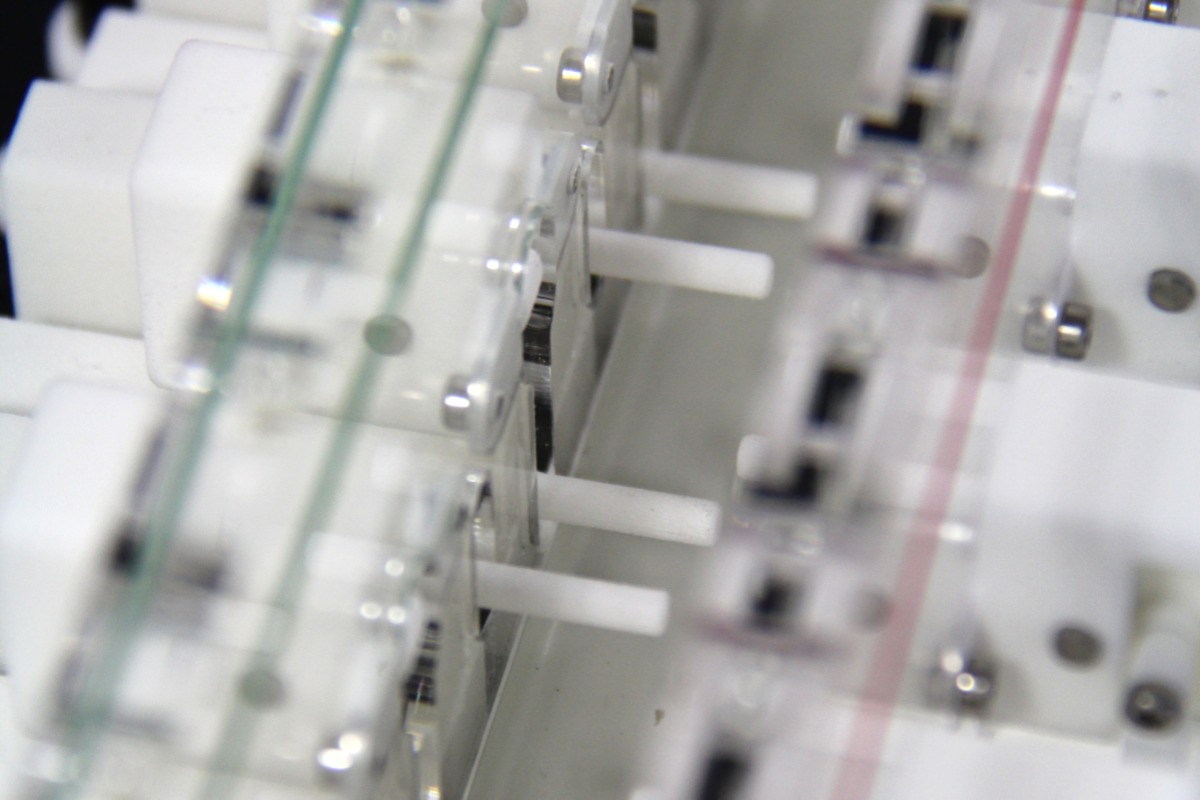
What a session looks like
Each trial is fully controlled by the ErasmusLadder software. Once the experimental planning has taken place in the software, acquisition is started from within the software. The apparatus will show which mouse is scheduled for the next session on the display. After the mouse is placed in one of the goal boxes, the session starts automatically. Read more about the software program here.
Leaving the goal box
At the start of the session, the mouse has a “time out” before a cue light is turned on. If the mouse does not leave the goal box after a certain number of seconds following the cue (the standard Erasmus MC protocol indicates five seconds), pressurized air is blown across the floor to urge the animal towards the ladder. During the “time out” period the animal is not allowed to leave the goal box. If it attempts to escape, the air flow from the opposite direction will force it back into the goal box.
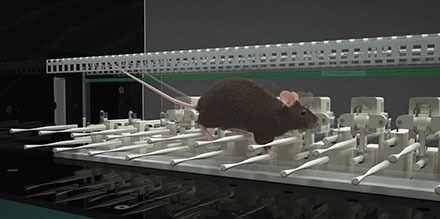
The first four sessions:
Learning to cross efficiently
Typically, the first sessions (four in the Erasmus MC protocol) are used to teach the mice to cross the ladder efficiently, and to measure their motor performance.
As soon as the animal leaves the goal box and is detected on the ladder, a second stream of air provides a backwind for the mouse, stimulating it to cross the ladder in a continuous matter. To ensure a constant backwind, the pressure of the air flow is adjusted for distance. The run ends when the animal enters the dark goal box on the opposite side. The air stops, starting a “time out” period before the next run in the opposite direction.
After all the data from one session in acquired, the data is sent back to the ErasmusLadder software for processing. The software will automatically reset the apparatus, and be ready for the next mouse to begin.
Testing motor performance and motor learning
The number of missteps and how this changes over consecutive trials is a measure of motor learning. Cupido et al. show that wild type mice have a high step time – they walk more slowly and place their paws more carefully. This results in fewer missteps compared to motorically challenged mice (which in Cupido’s case were a model for the fragile X-associated tremor/ataxia syndrome, a neurodegenerative disease). In the end, the fragile X mice showed a greater percentage of missteps, indicating a difference in motor performance (efficiency of learning to cross the ladder) from the wild type mice.
The last four sessions:
Testing reflexive motor learning
With ErasmusLadder, a reflexive motor learning paradigm can be carried out, allowing for assessment of cerebellar learning. Mouse is challenged with sudden appearance of an obstacle - higher rung (unconditioned stimulus), which is placed 12 mm above the stepping surface. Obstacle is announced by a tone (conditioned stimulus).
In the standard Erasmus MC protocol, mice are challenged in four sessions after they have been trained in four stimulus-free sessions.
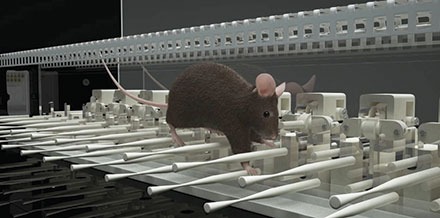
Testing the cerebellum
In the Erasmus MC protocol, the timing between the tone and the obstacle is 250ms, meaning that the animal has already initiated its movement towards the next rung by the time it hears the tone. The animal is then forced to alter its movement in order to avoid the obstacle. For this, proper functioning of the cerebellum is crucial.
Specific to the individual
The key feature of this paradigm is that the raising of the obstacle rung is based on the individual stepping pattern of that specific mouse in that specific trial. The software processes data in real time and calculates how the animal is moving in the beginning of the run, thus predicting where and when it will be placing its paw. This way, one of the rungs will be raised at the exact correct time. Beforehand, a tone will warn the mouse of this event. The software makes sure that the same barrier is not raised in consecutive runs.
Again, data is sent back to the computer after each session. There it can be selected, visualized, analyzed, stored, and exported.
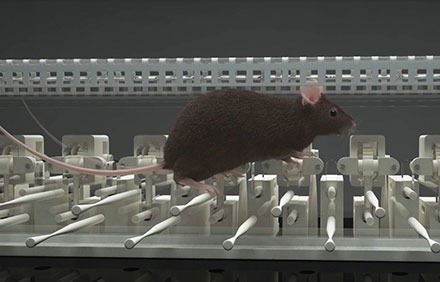
Dysfunction in associative motor learning
Mice with normal associative motor learning skills will learn over trials that the obstacle is unavoidable, and will adjust their stepping pattern accordingly. Cupido et al. show that wild type mice decrease their step time (they increase their velocity) right after hearing the tone. This is evidence of associative motor learning ability. In their study, they compared these results with those from a mutant strain, a model for fragile X syndrome. The fragile X mice showed clear motor learning deficits on ErasmusLadder in the perturbated (challenged) sessions, while there were not any significant differences in their step time or missteps during the training sessions.
 English
English German
German French
French Italian
Italian Spanish
Spanish Chinese
Chinese